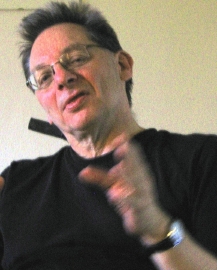I’m thrilled to present the sixth installment in this series of interviews with some of the gurus of both performance and applied storytelling. This interview is with Loren Niemi, whose work I first encountered while working on my dissertation. Read more about him below. I have broken his interview down into five parts, with one to appear each of the next five days.
Bio: Loren Niemi has spent 30 years as a storyteller, theatrical performer, and director of other performers. He is also a public policy consultant and trainer working with low-wealth communities and non-profit organizations to identify, frame and tell their critical stories.

Loren is the author of The Book of Plots (Llumina Press) on the use of narrative forms and Inviting the Wolf In: Thinking About Difficult Stories (August House Publishers) with co-author Elizabeth Ellis, on the value and necessity of the stories that are hard to hear and harder to tell. He teaches Storytelling in the Communications Department of Metro State University and offers consulting services and workshops on storytelling and cultural competency for organizations, businesses and communities around the world.
For more information, contact him at 651-271-6349, niemistory@aol.com or visit his website.
Q&A with Loren Niemi (Question 1):
Q: How did you initially become involved with story/storytelling/narrative? What attracted you to this field? What do you love about it?
A: There are several answers to this question, each of which responds to a corresponding level of awareness and commitment to storytelling.
The first came early, first grade, when the teacher asked what we knew about elephants. I gave an enthusiastic answer mixing fact and imagination. She said, you’re a liar. I said, no, I’m telling a story. While I was aware of the difference she did not acknowledge or “reward” the story, but shamed me with the result being that I did not raise my hand or speak unless called upon for the rest of the school year. This moment has remained with me for over 50 years and is core to my understanding that storytelling is fundamental to our education (integrating right and left-brain functions) and that everyone tells stories, consciously and unconsciously, to place themselves in the world, to build relationships and recognized for who they are as they choose to name/claim their identity.
By high school, that deep seated impulse to mix fact and imagination to make sense of the world lead me to the school paper and an award for creative fiction. It also got me my first kiss from an attractive woman when I told a wholly imagined story at a summer school leadership camp. These reaffirmed my sense of story as a powerful and rewarding use of language. There were also early lessons in these about the value and necessity of crafting material for a specific audience — matching language,
tone, rhythm to invite the listener into the story.
In 1971, I was working at an alternative education program for juvenile justice offenders. More than once I sat in a courtroom and heard a judge say to a kid, you can go to jail, into the military or into this program and have a kid think that it was the easy choice. We worked with them 12 hours a day, six days a week – and the core of the work was having them tell their stories over and over again in response to questions that were designed to move them from seeing themselves as victims of bad luck or other people’s ill will to taking responsibility for their own lives and decisions. It was a long and emotionally difficult process with more than one kid choosing to go into the military rather than stay with the program. Today it would probably be seen as a kind of Narrative Therapy, but then it was rooted in Gestalt and a Baba Ram Das sense of “Be Here Now.” In support of the work I began collecting and telling little metaphors, fables and parables (many from the Sufi, Zen and Hassidic traditions) to provide indirect models of behaviors, values, ways of thinking that supported the change process.
In 1978, I was managing projects the City of Minneapolis Arts Commission and was sitting in the bar of the Edgewater Hotel in Madison, WI, between arts conference sessions when I was asked what was it that I actually did. I’m a storyteller, I said. I help organizations and communities identify, shape and tell their stories. Once the words were out of my mouth, I understood that this was exactly what I did and more importantly, it was what I wanted to do. Story was the frame that made sense of the organizing, educational, political and arts streams that were all present in my life. Story was the common bond and conduit between them. Once the words were out of my mouth I could see how I had been prepared to be a storyteller and after, the doors of opportunity opened to demonstrate that this was my life’s work.
Within the next two years, I would meet and work with Ken Feit, Jay O’Callahan, Goyia Timpenelli, Mike Cotter, Elizabeth Ellis, Jim May and other leaders of the storytelling revival. Within three years I would be the Humanities Scholar in Residence in Northern Minnesota, paid to spend a year collecting and telling stories and documenting the cultural shift from an industrial to a tourism and service based economy. Within five years I would become the ringmaster and tour manager of the Circle of Water Circus, and there would be no turning back.
